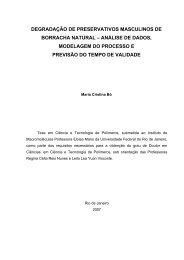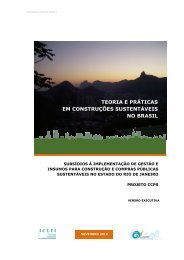EXAFS as a tool for catalyst characterization: a review of the ... - INT
EXAFS as a tool for catalyst characterization: a review of the ... - INT
EXAFS as a tool for catalyst characterization: a review of the ... - INT
You also want an ePaper? Increase the reach of your titles
YUMPU automatically turns print PDFs into web optimized ePapers that Google loves.
Thus, <strong>the</strong> resulting curves are fitted with <strong>the</strong> <strong>EXAFS</strong> <strong>for</strong>mula to<br />
determine R, N and σ . In order to extract in<strong>for</strong>mation about <strong>the</strong> local<br />
environment <strong>of</strong> <strong>the</strong> absorber, <strong>the</strong> backscattering amplitude and ph<strong>as</strong>e<br />
shift functions must be known. These functions can be obtained<br />
experimentally from <strong>EXAFS</strong> spectra <strong>of</strong> model compounds or calculated<br />
<strong>the</strong>oretically (Teo and Lee, 1979; McKale et al., 1988; Rehr, 1989).<br />
Experimental functions are extracted from reference compounds with<br />
known structures. However, it is not always possible to obtain<br />
experimental functions since <strong>the</strong> reference compounds do not exist or<br />
it is not possible to extract <strong>the</strong>m (Vlaic et al., 1998). Fur<strong>the</strong>rmore,<br />
experimental ph<strong>as</strong>e and amplitude functions must be extracted by<br />
using <strong>the</strong> same integration limits and <strong>the</strong> same windows to <strong>the</strong><br />
unknown sample in order to introduce <strong>the</strong> same truncation errors.<br />
In general, <strong>the</strong> accuracy <strong>of</strong> <strong>the</strong> analysis is about 0.01-0.02Å <strong>for</strong> <strong>the</strong><br />
interatomic distances, 5 to 15% <strong>for</strong> <strong>the</strong> coordination numbers and<br />
20% <strong>for</strong> σ (Lengeler and Eisenberger, 1980).<br />
The minimization procedure is carried over into <strong>the</strong> following function<br />
(Michalowicz, 1990):<br />
(14)<br />
where p i are <strong>the</strong> fitting parameters and W(k) is a weighting function.<br />
A residual factor is also defined by <strong>the</strong> following expression:<br />
(15)<br />
The number <strong>of</strong> parameters that can be determined from <strong>the</strong> <strong>EXAFS</strong><br />
signal is related to <strong>the</strong> number <strong>of</strong> independent points, N ind , by<br />
N par = N ind – 1 (16)<br />
There is some uncertainty in <strong>the</strong> literature on how to calculate N ind .<br />
According to Stern (1993), <strong>the</strong> correct expression is given by<br />
(17)<br />
The fit quality is given by <strong>the</strong> chi-square function. Particularly in<br />
<strong>EXAFS</strong> this function is defined <strong>as</strong> follows:<br />
(18)







![ABM 2012 Torquímetros 20801[1].pdf - INT](https://img.yumpu.com/35773768/1/184x260/abm-2012-torquimetros-208011pdf-int.jpg?quality=85)




![Resumo biodiesel 2012 Raquel Rev cla[1].pdf - INT](https://img.yumpu.com/27723744/1/184x260/resumo-biodiesel-2012-raquel-rev-cla1pdf-int.jpg?quality=85)



